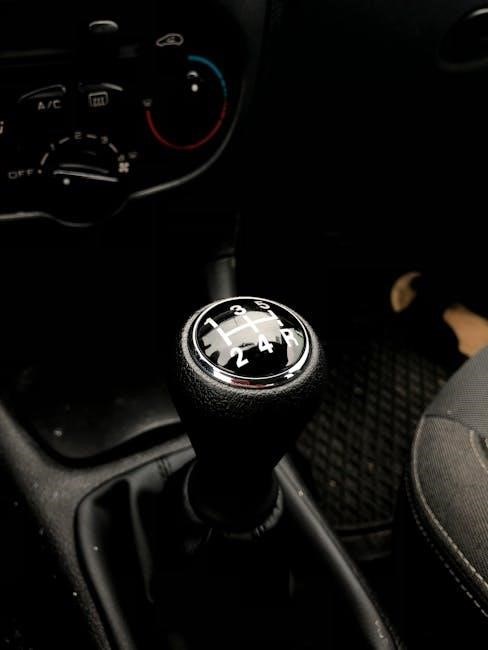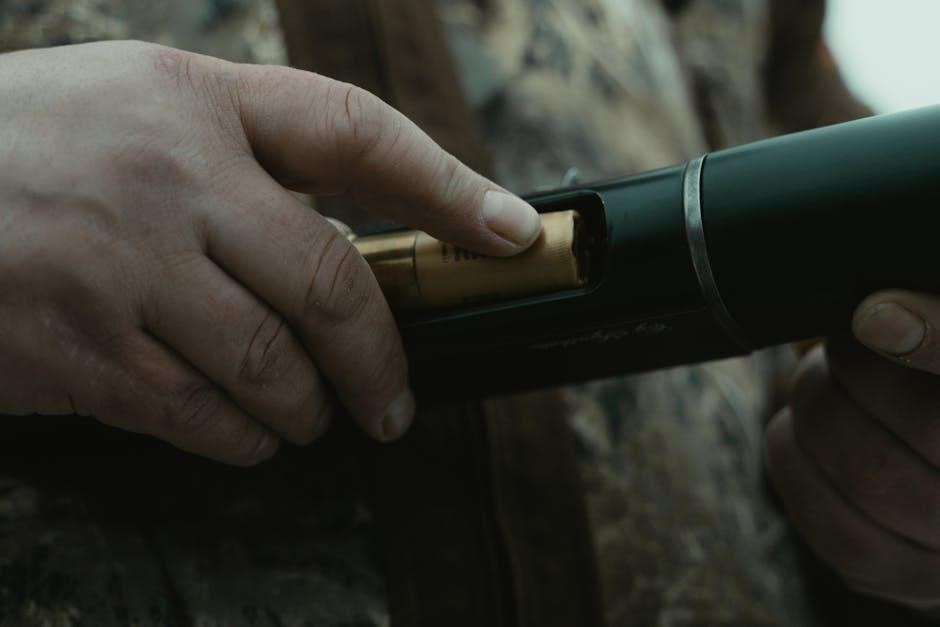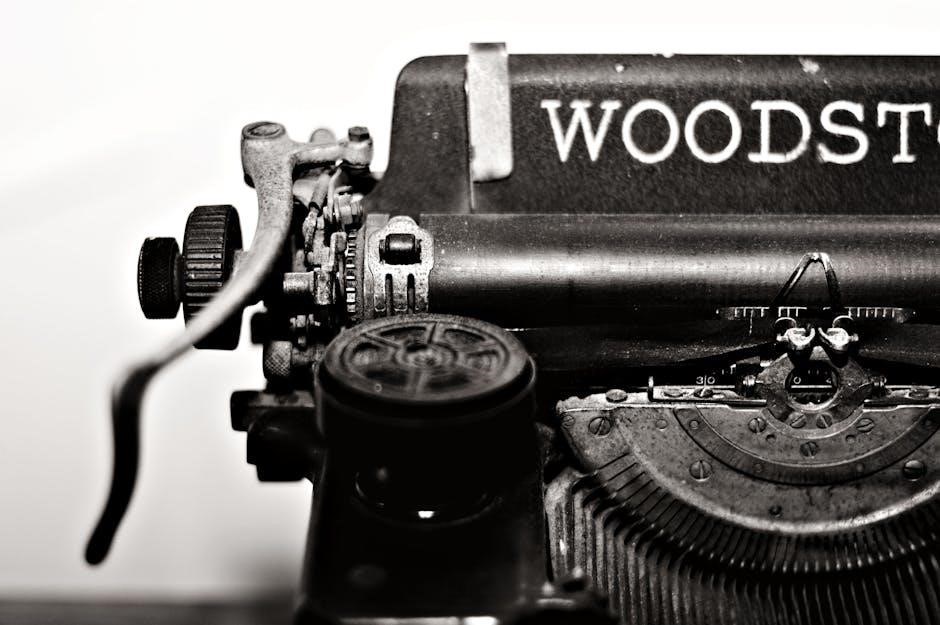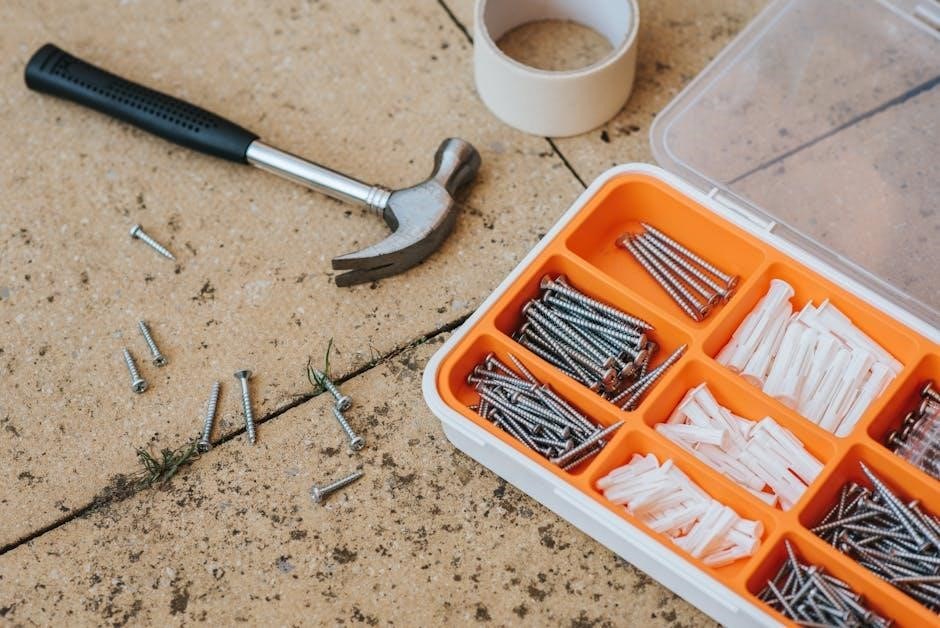Understanding Manual Transmission Issues
Manual transmissions popping out of gear can lead to safety hazards and mechanical damage. Understanding the root causes is crucial for effective troubleshooting and repair solutions.
Manual transmissions popping out of gear is a concerning issue that can lead to loss of control and safety hazards. It often indicates underlying mechanical problems‚ such as worn components or improper maintenance. Drivers may experience sudden‚ unexpected shifts into neutral or failure to stay in gear‚ especially during acceleration or deceleration. This problem can stem from various factors‚ including internal transmission wear‚ external interference‚ or driver error. Addressing the issue promptly is crucial to prevent further damage and ensure safe vehicle operation. Understanding the potential causes and symptoms is the first step toward effective troubleshooting and repair.

Common Causes of Manual Transmission Popping Out of Gear
Manual transmissions may pop out of gear due to internal wear‚ external interference‚ or maintenance issues‚ often requiring immediate attention to prevent further damage or safety risks.
Worn Synchronizers
Worn synchronizers are a common cause of manual transmissions popping out of gear. Synchronizers ensure smooth gear transitions by equalizing the speed of the gear and shaft. When worn‚ they fail to engage properly‚ causing the gear to slip out. This issue often occurs during shifting‚ especially under load or at higher RPMs. Symptoms include grinding noises‚ hesitation‚ and difficulty engaging gears. Replacing worn synchronizers is typically necessary to resolve the problem and restore smooth shifting performance. Regular maintenance and early detection can prevent further damage to transmission components.
Faulty Shift Linkage and Bushings
Faulty shift linkage or worn bushings can cause a manual transmission to pop out of gear. The shift linkage connects the gear shifter to the transmission‚ and worn or loose components can create excessive play. This play allows gears to disengage unintentionally‚ especially during acceleration or deceleration. Symptoms include a loose shifter‚ clunking noises‚ and gears slipping out of place. Over time‚ worn bushings or damaged linkage can lead to inconsistent shifting and potentially dangerous situations on the road. Replacing faulty shift linkage components and bushings is essential to restore precise control over gear selection and prevent further transmission damage.
Low or Contaminated Transmission Fluid
Low or contaminated transmission fluid is a common cause of gears popping out of place in manual transmissions. Transmission fluid lubricates internal components‚ prevents corrosion‚ and ensures smooth gear engagement. If the fluid level drops due to leaks or improper maintenance‚ critical parts like synchronizers and gear teeth can overheat and wear down. Contaminated fluid‚ often caused by moisture or debris‚ can also degrade the fluid’s lubricating properties. This leads to improper engagement of gears‚ causing them to slip out unexpectedly. Regular fluid checks and changes are vital to maintain transmission health and prevent such issues from arising.

Clutch System Problems
Clutch system issues‚ such as the clutch not fully releasing or a seized pilot bearing‚ can prevent proper gear engagement‚ causing the transmission to pop out of gear.
Clutch Not Fully Releasing
A clutch that fails to fully disengage can prevent proper gear engagement‚ causing the transmission to pop out of gear. This issue often arises from a seized pilot bearing or worn clutch components. When the clutch pedal is pressed‚ it should release the clutch disk from the flywheel. If it doesn’t fully disengage‚ the gear may not engage smoothly‚ leading to unexpected slipping. Symptoms include difficulty shifting gears and a grinding noise. Addressing this requires inspecting the clutch system‚ including the pilot bearing and release mechanism. Proper clutch function is essential for maintaining control over gear shifts and ensuring smooth transmission operation. Regular maintenance can help prevent such issues.
Seized Pilot Bearing
A seized pilot bearing is a common culprit behind manual transmissions popping out of gear. The pilot bearing‚ located in the center of the clutch‚ supports the transmission’s input shaft. When it seizes‚ it restricts the input shaft’s movement‚ causing the gears to disengage unexpectedly. Symptoms include a loud grinding noise‚ difficulty shifting gears‚ and the transmission slipping out of gear while driving. A seized pilot bearing often results from lack of lubrication or wear over time. If left unaddressed‚ it can lead to further damage to the clutch and transmission components. Replacing the pilot bearing is typically required to resolve the issue and restore smooth gear engagement. Regular maintenance can help prevent such problems from arising.

Internal Transmission Components
Internal issues like damaged gear teeth or weak detent springs can cause the transmission to pop out of gear. These components‚ when worn or compromised‚ fail to hold gears in place‚ leading to unexpected disengagement during operation.
Damaged Gear Teeth
Damaged gear teeth are a common cause of manual transmissions popping out of gear. When gear teeth become worn‚ chipped‚ or rounded‚ they fail to mesh properly‚ leading to unexpected disengagement. This issue often results from aggressive driving‚ such as shifting at high RPMs or improper gear engagement. Over time‚ the stress on the gears can cause teeth to break or wear down‚ creating gaps where the gears can slip out of alignment. If left unaddressed‚ this can lead to further damage to surrounding components and make shifting difficult or unreliable. Regular inspection and maintenance are crucial to prevent such issues from arising.

Weak Detent Springs
Weak detent springs are another common culprit behind manual transmissions popping out of gear. Detent springs play a critical role in holding the gear in place by providing the necessary tension to keep the shift fork engaged. When these springs weaken or lose their tension‚ the shift fork can move out of position‚ causing the transmission to slip out of gear unexpectedly. This issue is often exacerbated by high mileage or wear over time. Replacing weak detent springs is typically the recommended solution to restore proper gear engagement and prevent further complications. Regular maintenance can help identify such issues before they become major problems.

External Factors
External factors such as worn engine mounts and external physical stress can contribute to the manual transmission popping out of gear during operation. Worn engine mounts can cause instability‚ leading to gears disengaging.

Incorrect Transmission Fluid Usage
Using the wrong type or grade of transmission fluid can lead to improper lubrication and gear engagement issues. This can cause the synchronizers to malfunction‚ resulting in gears popping out. Contaminated or degraded fluid may also reduce the transmission’s ability to maintain gear engagement‚ increasing wear on internal components. Always use the manufacturer-recommended fluid to ensure optimal performance and prevent premature wear. Incorrect fluid usage can exacerbate existing problems‚ such as worn synchronizers or damaged gear teeth‚ making the issue more pronounced. Regular fluid checks and changes are essential to maintain transmission health and avoid unexpected disengagement while driving.
Worn Engine Mounts
Worn engine mounts can contribute to manual transmissions popping out of gear‚ especially during acceleration. Engine mounts stabilize the engine and absorb vibrations‚ but when they wear out‚ excessive engine movement transfers to the transmission. This can cause the shift linkage and transmission mounts to endure additional stress‚ leading to misalignment and improper gear engagement. Over time‚ this strain may result in gears disengaging unexpectedly. Symptoms include noticeable vibrations or noises during acceleration; Inspecting and replacing worn engine mounts can help restore stability and prevent further transmission issues. Addressing this problem early is crucial to avoid more severe damage to the transmission system.

Driver-Related Issues
Improper shifting techniques‚ such as sudden acceleration or aggressive gear changes‚ can stress the transmission‚ leading to gears disengaging. Driver error is a common factor.
Improper Shifting Techniques
Improper shifting‚ such as aggressive acceleration or sudden gear changes‚ can cause the transmission to pop out of gear. Drivers may inadvertently apply too much pressure or fail to fully engage gears‚ leading to disengagement. Riding the clutch or resting the hand on the shifter while driving can also contribute‚ as it may unintentionally move the shift lever. Additionally‚ not using the clutch fully or shifting too quickly can strain the synchronizers and gears‚ increasing wear and the likelihood of gears disengaging. Proper training and smooth driving habits are essential to prevent these issues and extend transmission life.
If your manual transmission is popping out of gear‚ it’s essential to address the issue promptly to prevent further damage. Start by checking the transmission fluid level and condition‚ ensuring it’s clean and at the recommended level. Inspect the shift linkage and bushings for wear or damage. If issues persist‚ consider consulting a mechanic to evaluate internal components like synchronizers‚ gear teeth‚ and detent springs. Improving shifting techniques and avoiding resting your hand on the gearshift can also help prevent disengagement. Professional diagnosis and timely repairs are crucial to maintain your car’s performance and safety on the road.
Diagnostic and Repair Recommendations

To address a manual transmission popping out of gear‚ start with a thorough inspection of the shift linkage‚ bushings‚ and synchronizers. Check the transmission fluid level and condition‚ ensuring it’s clean and at the correct grade. Inspect for worn or damaged components like gear teeth‚ detent springs‚ or the pilot bearing. If the issue persists‚ a professional mechanic should evaluate internal parts for wear or damage. Repair may involve replacing faulty components or rebuilding the transmission. Improving shifting techniques and avoiding resting your hand on the gearshift can prevent recurrence. Regular maintenance and prompt repairs are key to ensuring long-term performance and safety.
